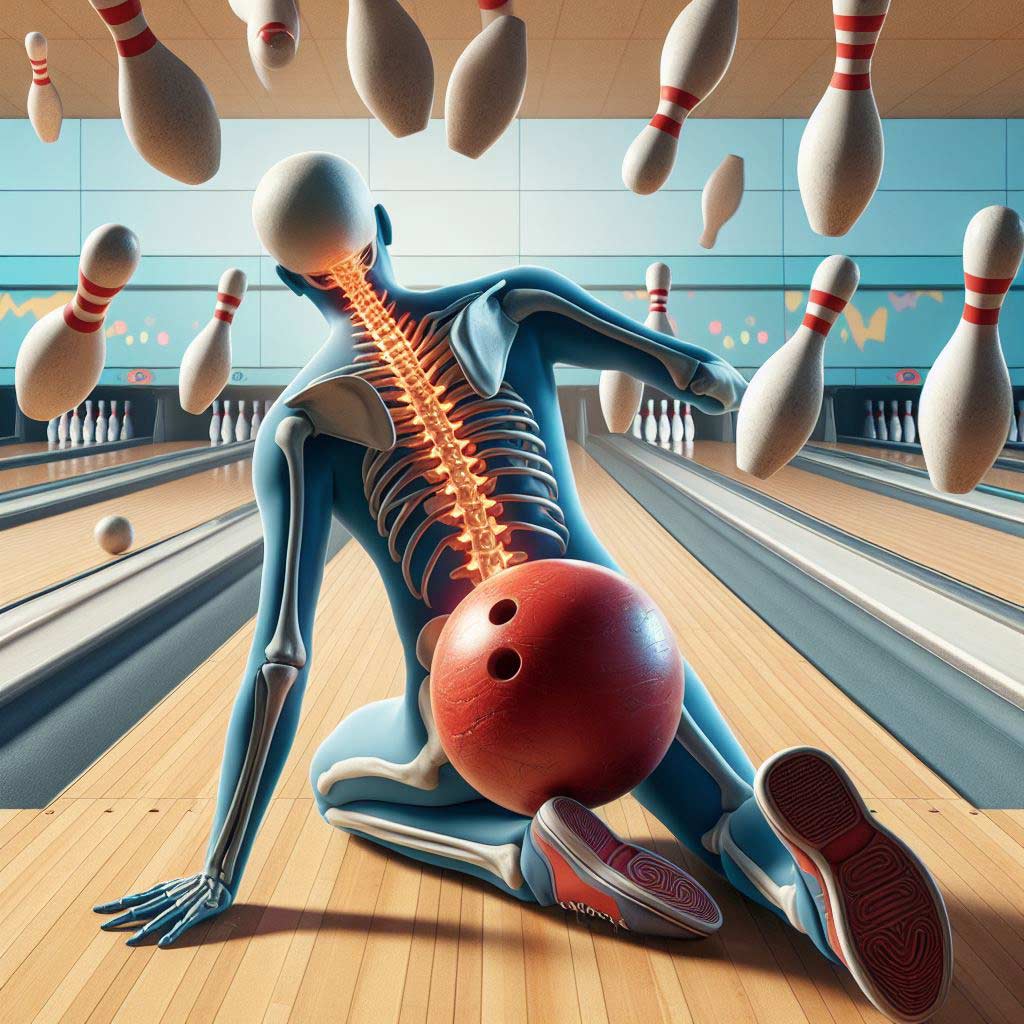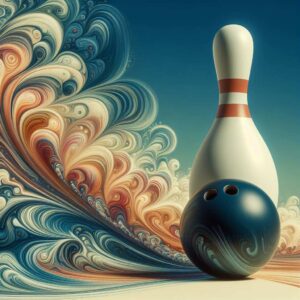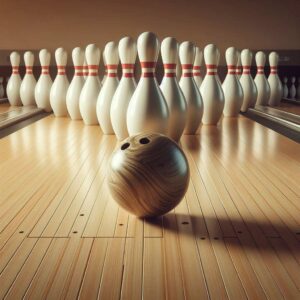As an avid bowler for over 10 years, I’ve had my share of back flare-ups from being on the lanes for hours at a time.
It first started as a twinge if I overdid the bending and twisting motions from my windup to release. But soon a sharp pain near my lower right side would kick in around game three.
I realized my core and back just couldn’t endure the repetitive strain for so long without strengthening and proper technique adjustments.
After being forced to take a couple of weeks off to rest my nagging back spasms, I studied up on causes and preventative tips so I could get back out on the lanes pain-free.
Even with being more mindful, I still get the occasional ache if I haven’t warmed up properly or maintained my muscle flexibility.
If you’re an active bowler, you’ve likely experienced some type of back discomfort as well. Let’s cover why this sport notoriously over-strains the back, risk factors to be aware of, and proactive injury prevention methods.
Understanding contributing factors and smart training choices we make off and on the lane can help avoid unwanted downtime from back injuries.
Common Causes of Bowling Back Pain and Injuries
Bowling seems like a casual lower-body sport, but the torque and flexing engage your entire core and spine.
If muscles are tight or weak, the lower back takes a direct hit with each exaggerated twist, bend, and swing in the ball release follow-through.
Some common culprits of bowling-related back pain include:
Improper or Excessive Back Bending
Bending and straightening too aggressively or improperly during your backswing and downswing can tweak muscles and cause disc issues over time.
Repeated compressed bending is problematic for spinal health. Using proper squat lowering and lifting strength prevents overtaxing the back.
Overstretching
Reaching too far back for more power leverage overworks muscles leading to tears or strains. Flexibility is important but should build up slowly over time.
Rushing into splits or toe touches well beyond your current range with cold, tight muscles is an injury recipe.
Repetitive Twisting
The torso rotates with each bowling swing, winding up and then releasing with a twist. This repetitive side-to-side motion can inflame tissues and cause micro tears if not strengthened properly over time.
Poor Ball Fit and Grip Issues
Using a weighty ball that doesn’t fit your hand size well leaves the grip doing all the heavy lifting work. This indirectly creates strain elsewhere to compensate including hunching the back.
Custom drilling provides ideal finger hole placement so the weight distributes through your hand not just the grip points.
Muscle Overuse and Strains
When overworked and exhausted, back muscles give out more easily when continuing to bowl through fatigue. Ligaments and tendons take the brunt after muscles max out leading to painful sprains and tears.
Spinal Conditions Such as Degenerative Disc Disease
Those with existing back problems like arthritis, degeneration, herniations, and nerve issues are most prone to bowling back pain from the compressive and twisting movements involved. Protect existing vulnerabilities with careful body awareness.
Most Common Bowling Back Injuries
The most frequently occurring back injuries bowlers face from the sport often involve spasms, strains, or spine conditions:
- Pulled Back Muscles – Acute strain from overextension
- Bulging/Herniated Discs – Leaking disc causes nerve impingement
- Sciatica – Inflamed sciatic nerve from spine/disc problems
- Spondylolisthesis – Vertebral slippage placing pressure on nerves
- Low Back Spasms – Involuntary contractions from overuse
Knowing contributing injury factors helps determine personalized prevention tactics and areas to address modification with coaching. Let’s examine common risk factors bowlers should be aware of next.
Risk Factors That Can Increase Likelihood of Back Injury
Not everyone follows the same training regimen, gets professionally fitted pro-shop balls, or takes the same precautionary measures.
Just as your degree of skill level at bowling varies personally to you, so can your relative risk for related injuries. Those more predisposed include athletes who:
Lack Warm-Up and Stretching Routines
Starting bowling without properly getting the blood circulating increases vulnerability for muscle pulls and tears. Stretching lengthens connective tissue so it withstands quick torquing motions better.
Use Poor or Lazy Technique
Proper wrist, arm, shoulder, and back positioning matters when bowling without injuring form. Pay attention to where hook power should leverage from the legs and core instead of all spine twisting or hinging solely from the back.
Have Physical Conditions or Chronic Back/Nerve Problems
If you have spinal arthritis, compressed discs, or sciatica, the sport essentially aggravates your existing condition directly in the problem zones from repetition.
Bowl for Long Durations Marathon Style
Extended bowling for hours fatigues the intricate stabilizing muscles that protect the spine from taking on all strain directly. This vastly elevates cumulative injury risk over time. Give muscle groups recovery periods.
Utilize Balls Too Heavy for Skill Level
Using a 15 or 16-pound ball when core body strength better suits a 12 or 14-lb ball overtaxes muscles quickly. Don’t attempt to bowl above your current training level to appear advanced.
As in any fitness realm from CrossFit to tennis, individual variance contributes to who’s most at risk for certain injuries.
Awareness of personal vulnerabilities allows you to take preventative action through cross-training, technique adjustments, rest allowance, muscle recovery methods, and not over-bowling beyond your current ability.
Tips to Help Prevent Bowling Back Pain and Injury
Outside of doctor-recommended treatment for existing back problems, let’s discuss proactive self-care steps you can implement to continue bowling pain-free:
Strengthen Core and Increase Flexibility
The stronger your core trunk and outer hip muscles, the more shock absorption support your lower spine has when torquing.
Pilates moves like planks, bird dogs, bridge lifts and stability ball pikes strengthen bowling muscle groups with less strain.
Gentle-focused stretching creates length in connective tissues so they move fluidly without over-straining.
Maintain Proper Spine Alignment and Bend
Be mindful not to round your upper back or over-tuck your pelvis so the spine stays neutral not putting pressure on discs and nerves.
Initiate bending the knees with a squat when lowering to release the ball more so than overly bending the straight back.
Use Proper Lifting Technique with the Ball
Lift the ball properly starting the movement by straightening the legs to standing instead of solely relying on back muscles to pick the ball off the floor.
Keep shoulders broad when lowering into the backswing as well so ribs don’t collapse inwards over straining the spine.
Ensure Ball Weight Fits Your Hand Size
The bowling ball should feel balanced and stable in your hand without excess finger, hand, or forearm tension to grip and cradle during the pendulum swing.
Weight determines overall leveraged momentum energy, but make sure hand placement fits your span without squeezing pressure.
Always Warm Up Before Bowling
Take 5-10 minutes to warm up muscles through a full range of motion before starting competitive play. Light cardio kicks blood flow into connective tissues so they move freely reducing strain risk.
Dynamic moves that open the spine and hips in all bowling planes will prime you for pain-free movement.
Listen to Physical Pain Signals
If you start feeling strained, shooting pains, or muscle spasms…stop bowling! Work through a few gentle stretches and give the area a rest until it dissipates before continuing to prevent serious acute injury. Minor discomfort now can help avoid major issues later. Don’t play through sharp sudden pain!
Take Consistent Rest Breaks
Force your body to cool down and recover during training by resting every hour even if you don’t feel like you need it yet.
Hydrate and stretch lightly before hitting the lanes again for the next round. The breaks let muscles unwind tension and prevent fatiguing your core stabilizers into collapse.
The list gives you practical ways to assess and support current bowling capability so you practice safely within your optimal window. Next, let’s go over effective medical treatment options if you experience a bowling-related back injury.
Treatment Options for Bowling Back Pain Injuries
Seeking professional care advice is recommended if back pain lingers beyond a couple of days or you experience sudden weakness/numbness from nerve compression needing emergency room evaluation. Conservative treatment measures bowlers find relief with include:
Chiropractic Care
Chiropractors specialize in muscular skeletal injuries involving nerve impingements that respond well to gentle spine and joint manipulation tension release, therapeutic stretches, and muscular recovery exercises.
Physical Therapy
Working with a back/spine specialized physical therapist utilizing modalities like heat/ice therapy, electro-stim, personalized stretching programs, and correctly graded strength training often alleviates chronic issues caused by bowling strain.
Yoga and Focused Stretches
Gentle forms of vinyasa yoga that mindfully move the body through postures opening up connective tissue and building strength in a controlled supported manner help open up the areas that get so compressed like the hips and thoracic spine. Therapeutic stretches create space and length.
Massage
Whether professional sports therapy clinical or self-myofascial release, localized massage boosts blood flow to enable oxygen/nutrient delivery to strained tissues for faster recovery. Tense muscle knot release also reduces painful trigger point spasms.
Medications
Over-the-counter products like NSAID pain relievers, muscle relaxants, and analgesic heating creams manage symptoms short term but don’t fix the root issue. Use temporarily alongside physical rehabilitation efforts.
Heat/Ice
Knowing when heat vs ice applications accelerate recovery makes a difference. Use heat for stiffness and chronic pain but ice for acute sudden injuries to reduce short-term inflammatory swelling. Contrasting hot/cold therapy adds extra circulation benefits.
Temporarily Cease Bowling
If basic stretching and heat don’t seem to make an impact after 48 hours, your body likely needs an extended time completely off bowling and other straining movements for disc or ligament tears to mend through rest and light realignment exercises. Listen to your pain!
Surgery
As a very last resort with long-term unresponsive nerve injuries, compressed fractures, or disc protrusions sometimes surgery becomes indicated if more conservative therapies fail to help after an extended dedicated course.
However many invasive back operations still face complication risks and lengthy recovery. Avoid unless absolutely no other option exists.
Surgery aims to stabilize vulnerabilities not fix acute injury causes needing rehabilitation adaptation. Make personal training adjustments before considering this route.
Be proactive to avoid getting to a painful point of needing extensive treatment in the first place since back injury recuperation periods span longer than other body parts.
If you love bowling, commit to careful strength-building, mobility, and recovery training between alley sessions so your body withstands the workload without breaking down. Monitor warning signals closely.
Key Takeaways on Preventing Back Pain from Bowling:
- Warm up muscles through full range first
- Learn proper squat lifting form
- Increase core/glut strength and hip flexibility
- Ensure ball finger hole fit
- Take breaks hourly
- Do not play through sudden pain
- Stretch lightly after each game session
With some diligence about prevention and responding promptly if any pain arises, you can enjoy bowling for the long haul without sacrificing your back health.
Stay tuned for more tips on bowler vitality next time! Let the pins start flying and have fun rolling strikes out there!
Frequently Asked Questions
What is the most common injury in bowling?
The most common bowling injury is muscle strains and tears affecting the shoulder, back, wrist, and knee from the repetitive motion required. Lower back pain and strain are most frequently reported.
Can bowls cause back pain?
Yes, the repetitive bending motion and torquing in the lower body required in the bowling swing and release can cause back soreness and pain over time by overworking the paraspinal muscles.
What helps with pain after bowling?
Applying heat, gentle stretching, Epsom salt baths, chiropractic adjustment, massage, and over-the-counter anti-inflammatory medication can help alleviate post-bowling back pain. Building core strength and resting strained tissues are also key.
Can you pull back muscle from bowling?
It’s quite common to pull or tear a back muscle when bowling from over-rotation, improper bending, using a ball that’s too heavy, or fatigue. Acute pain from overextending the paraspinal muscles usually results from repetitive quick torquing motions.
Can bowling cause muscle pain?
Yes, bowling commonly leads to delayed onset muscle soreness (DOMS) from small micro tears and inflammation created in the repetitive stretching and contracting of muscles during play. The lower back, shoulder, knees, and wrist flexors often flare up.
What injuries can you get from bowling?
Common bowling injuries beyond back pain include wrist sprains or fractures, knee tendinitis, shoulder impingement syndrome or bursitis, elbow tendinitis, and forearm muscle strains from gripping the ball continually.
What symptoms can back pain cause?
Symptoms from back injuries range from muscle soreness, spasms, and stiffness to mobility issues, shooting or radiating nerve pain, numbness/tingling, and foot weakness from disc, nerve, or spinal joint problems. Pain ranges from mild to debilitating.
What is causing lower back pain?
Common causes of lower back pain include muscular strain from overuse or tears, ligament sprains, spinal conditions like arthritis or degenerative discs, bulging/herniated discs, sciatica, bone fractures, kidney issues, and in rare cases tumors or infections.
What are the reasons for lower back pain?
Reasons for developing low back pain extend beyond injury to muscle imbalances, poor posture and movement patterns that reinforce misalignment, lack of core strength, excess body weight forcing the spine out of neutral, anxiety, stress, and chronic inflammatory conditions. Prevention involves addressing root contributors.





